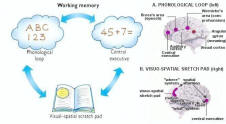Special GoogleHealth Search
|
|
|
|
|
continued
from the Brain Page of Nervous System
Contents
Neurons and Nerves
neurotransmitter
The Brain & Spinal Cord
Cranial Nerves
Peripheral Nervous System
Autonomic Nervous System
Senses:
Eye diagrams,
Hearing,
Smell,
Taste,
Taste
& Tongue
Sensation,
Balance
Memory ,
Memory types,
Creation of Memory,
Higher Functions
Altered States
[Top]
| Type |
Location(s) |
Function |
Example(s) |
| Working Memory |
|
|
|
| Phonological Loop |
Left hemisphere |
Rehearsing verbal information to keep it in the
short-term memory |
String of numerals and alphabets such as telephone
numbers |
| Visual-spatial Scratch Pad |
Visual Cortex |
Controlling visual imagery |
Scanning text |
| Central Executive |
Frontal lobe |
Controlling awareness of the information in working
memory |
Constructing sentence, comprehending
speech |
| Non-declarative Memory |
|
|
|
| Procedural Memory |
Cerebellum, temporal lobes |
Managing "how to" |
Riding a bicycle,
kungfu
exercise |
| Classical Conditioning |
Cerebellum |
Forming habitual behaviour |
Coffee break,
afternoon
tea |
| Fear Memory |
Amygdala |
Emotional conditioning |
Phobias, flashbacks |
| Nonassociative Memory |
Spinal cord |
Habituation and Sensitization |
Decreased or increased responsiveness to stimulus |
| Remote Memory (Priming) |
Scattered around the cortex |
Foundation for new memories |
Childhood memory |
| Declarative Memory |
|
|
|
| Episodic Memory |
Cortex |
Remembering past experience |
Some enchanted evening |
| Semantic Memory |
Frontal lobe, temporal lobe |
Registering facts |
Meanings of words and
symbols |
Table 06 Types of Memory
- Working Memory -Most of our memories are fleeting because
few of the many experiences we have in the course of an average
day are remembered for very long, nor do they need to be.
Transient memories are absolutely essential to the process of
understanding the meaning of events as they occur in the
present. This type of very short-term memory for things being
experienced now is known as working memory; it allows you to
comprehend what you are reading or to figure out the meaning of
what has just been said to your in a conversation. Working
memory can be thought of as a low capacity information reservoir
that is always full, sensations flowing into it continuously at
about the same rate that they are forgotten. Some of the
information held in short-term storage may be important enough
to be remembered for a long time and must therefore be
transferred to a more stable form of storage, which is
represented by far more robust
 |
alterations in the
brain's chemical and physical make-up in the form of
synaptic connections. It is not necessarily for an
important experience to trigger the formation of
long-term memories, other factors such emotion,
practice, and rehearsal also facilitate the
transformation. Experiments show that in all cases the
most important underlying distinction between the short-
and long-term memory formation is that the latter
requires a dialogue between synapses and genes and the
former does not.
Continued
to working memory page |
|
|
|
